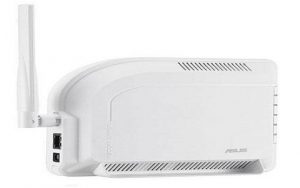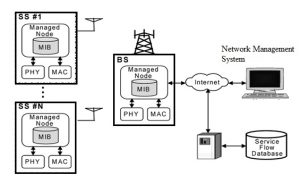Technology like wireless broadband provides a connection with high-speed over the air. This kind of technology utilizes radio signals to send & receive data from the users directly whenever they desire it. Different wireless technologies work together like WiFI, 3G, UWB & WiMax technology to meet up customer requirements. Wireless broadband (WBA) is a point to multipoint system that is made up of subscriber equipment & base station. The base station works through an external antenna instead of working with the physical connection among the subscriber as well as the base station to transmit & receive data with high-speed & equipment from voice to the subscriber. So, wireless broadband access provides an efficient, complementary solution for wire-line broadband, so it is recognized globally by the population. This article discusses an overview of a wireless broadband access technology namely WiMax.
What is WiMax Technology?
WiMAX is a wireless broadband access technology based on an internet protocol and its performance is equivalent to Wi-Fi networks/802.11 by the coverage & quality of service of cellular networks. WiMAX full form is “Worldwide Interoperability for Microwave Access. A wireless digital communication system like WiMAX is also called IEEE 802.16 that is designed for wireless MANs (metropolitan area networks).
WiMAX communication system provides BWA (broadband wireless access) up to 50 kilometers for fixed stations and also for mobile stations from 5 to 15 km. WiMAX is a broadband wireless technology that provides broadband access services for enterprise & residential customers in a reasonable method.

WiMAX Modem
WiMax replaces DSL services and cables by providing internet access universally. The architecture used in WiMax is the point to multipoint, which is an ideal technique for carriers to deliver broadband to locations wherever wired connections are costly and difficult. A WiMax connection can also be routed or bridged toward a standard wired otherwise wireless LAN.
The operation of WiMax is similar to WiFi, however at high speeds above larger distances for several users. This wireless broadband has the capacity to provide service even in difficult areas to reach & the capability to defeat the physical boundaries of usually wired infrastructure.
Parts of WiMax
The WiMax system includes two parts like WiMAX tower and the WiMAX receiver.
- WiMAX tower is similar to a cell phone tower and it provides signal coverage to a very large area like 3,000 square miles.
- In a WiMAX receiver, the antenna and the receiver could be a tiny box that can be built into a laptop like the WiFi access at present.
WiMax Speed and Range
WiMAX offers up to 40 Mbps capacity for each wireless channel in both fixed & handy applications based on the specific technical design selected, sufficient to hold the number of businesses through T-1 speed connectivity as well as houses through DSL speed connectivity. This broadband wireless technology support video, voice, and voice as well as Internet data.
WiMax provides wireless broadband access to buildings, wired networks, rural otherwise populated regions. It connects WLAN hotspots toward the Internet and also it provides connectivity of broadband for mobile devices. The expected speed is about 15 Mbps in a 3 km cell coverage region.
From current internet access arrangements, WiMAX, users could actually cut free and it could be potentially arranged in different spectrum bands like 2.3Giga Hz, 2.5Giga Hz, 3.5Giga Hz & 5.8Giga Hz
Standards of WiMax Technology
The different IEEE standards of WiMax are discussed below.
802.16-2001
This is the first version of the IEEE standard which is approved in the year 2001
802.16a-802.16c
After the 802.16-2001 version, the versions like 802.16a-802.16c were approved which are simply the alterations of the above version.
802.16-2004
This is the current IEEE standard and it is approved in June 2004 which makes the previous versions 802.16-2001 through its improvements 802.16a-802.16c outdated.
802.16-2005 (802.16e)
The IEEE 802.16-2004 standard addresses simply fixed systems. An adjustment is within the works which include mobility component toward the standard. This adjustment comes in a new standard like IEEE 802.16-2005, which is approved in Dec 2005 and is formerly called 802.16e.
WiMAX Architecture
The WiMAX architecture was developed by WiMAX form supports and it is combined network architecture that supports nomadic, fixed & mobile operations. This architecture depends on all internet protocol models. This architecture includes three main elements like remote stations or mobile stations, ASN (access service network) & CSN (connectivity service network).

WiMAX Architecture
Remote Stations/Mobile Stations
These stations are the user apparatus like mobile and that may be placed within the location of the consumer.
ASN (Access Service Network)
The access service network in the region of the WiMAX network and forms the radio access network on the border. This network includes one or several gateways and base stations.
CSN (Connectivity Service Network)
The connectivity service network is one of the main elements of the WiMAX network that provides internet protocol connectivity & all the functions of the internet protocol core network.
The WiMAX network includes different entities which include the following.
SS (Subscriber Station) or MS (Mobile Station)
The Subscriber station or SS is frequently known as CPE or Customer Premises Equipment which uses different forms like indoor CPE otherwise outdoor CPE. The indoor customer premises equipment can be placed by the operator. These are frequently available in a dongle form which is used for a laptop and different applications. The outdoor customer premises equipment provides good performance.
Base Station or BS
For the WiMAX network, the base station or BS forms an important element to provide the air interface for mobile stations & the subscriber. The base station is responsible for extra functionality of micro-mobility management functions like the establishment of the tunnel, handoff triggering, policy enforcement of QoS, radio resource management, classification of traffic, Dynamic Host Control Protocol(DHCP) proxy, multicast group management, session management & key management.
ASN-GW/ASN Gateway
In WiMAX network architecture, the access service network gateway normally works like a layer-2 traffic aggregation point in the overall network. This network provides extra functions like paging, intra-ASN location management, admission control, radio resource management, encryption keys & caching of subscriber profiles. This network may also comprise the mobility tunnel management through base stations, the establishment of AAA client functionality, policy enforcement, QoS, routing to the selected CSN & functionality of foreign agent for mobile IP.
Home Agent or HA
In the WiMAX network, the HA (Home Agent) can be placed in the connectivity service network. A key element in WiMAX technology can be formed with mobile IP and the home agent works within conjunction through a Foreign Agent like ASN Gateway for giving a proficient back-to-back Mobile IP solution. For subscribers, the HA serves to provide secure roaming through QoS capabilities
AAA – Authentication, Authorization & Accounting Server
A service like AAA has been used in any communications otherwise subscription services for a wireless system. This is included in the connectivity service network or CSN.
Difference between WiFi and WiMAX Technology
The main difference between WiFi and WiMAX include the following.
| WiFi | WiMAX |
| The short form of Wireless Fidelity is WiFI | The short form of Wireless Inter-operability for Microwave Access is WiMAX |
| In the year 1997, WiFi was launched | In the year 2004, WiFi was launched |
| Wifi does not assurances QoS or Quality of Service. | WiMax assurances QoS (Quality of Service) |
| WiFi is used for Local Area Network (LAN) applications. | WiMAX is mostly used for Metropolitan Area Network (MAN) applications. |
| The network-like Wifi ranges at a maximum of 100 meters. | The network-like WiMax range is a maximum of 90 km. |
| The transmission speed of WiFi is up to 54 Mbps. | The transmission speed of WiMAX is up to 70mbps. |
| The range of distance of WiFi is short | The range of distance of WiMAX is long |
| WiFi works with Radio waves to make high-speed internet wirelessly & network connections. So, Hotspots can be created through a wireless adapter. | WiMAX works with spectrum to bring connection toward network & handle a superior network. |
| MAC layer of WiFi works with a protocol like CSMA/CA which is not connection-based. | WiMax network is connection based |
| Wifi uses IEEE 802.11x standard where x denotes several WiFi versions. | WiMax uses IEEE 802.16y standard where y denotes several WiMax versions. |
| The encryption techniques used in Wi-Fi are RC4 & AES (Advanced Encryption Standard) | The encryption techniques used in WiMAX are Advanced Encryption Standards & Triple Data Encryption Algorithm. |
| WiFi frequency range is 2.4 GHz & 5 GHz | WiMAX frequency range is 2.3 to 2.4 GHz, 2.5 to 2.7 GHz & 3.4 to 3.6 GHz |
WiMax Technology Applications
The WiMAX uses include the following.
- The applications of WiMAX broadband technology is mainly focused on wireless MAN based on the strengths and characteristics
- It can be used as a complement to wired broadband access technologies for enhancing the flexibility & coverage of broadband access. Alternatively, it is regarded as a Wireless MAN technology through Wi-Fi. The two technologies individually serve LAN & MAN that are opposite to each other.
- WiMAX network is capable for the service providers to arrange new broadband service. At present these applications are most effective and provide a wide customer base when including a mobility characteristic to those services.
- WiMAX brings a new element to the present’s mobile community and the most important applications of this technology include consumer connectivity, business & backhaul.
- By using this technology, a client can arrange momentary communication services as well as accelerate their network for supporting situations & events.
- This technology allows you to get momentary access to visitors, employees & media
- The basic strength of WiMAX Technology is security, high-quality services, high bandwidth, deployment, etc.
Please refer to this Link for Nanotechnology MCQs
Please refer to this Link for Satellite Communication Question & Answers
Please refer to this Link for Digital Communication MCQs
Please refer to this link for WiMax MCQs
Thus, this is all about an overview of WiMAX technology and the applications of this technology are service providers for current data, voice, video, mobile & internet access. This technology provides several benefits like cost-saving, service efficiency & capable to permit mobile devices for making video & data transfer with high speed. Here is a question for you, what are the disadvantages of WiMAX?